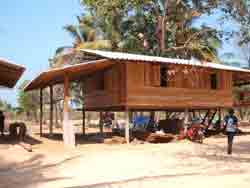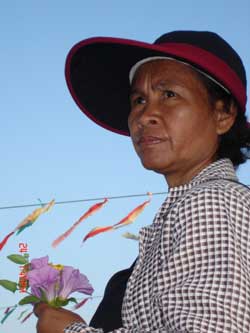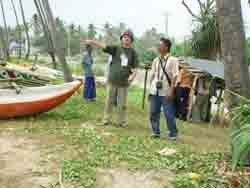| Tsunami Thailand | On this page ....
many concrete strategies, used by the Thai networks, to promote people centered rehabilitation For other stories visit our Thai Extras page. |
||||||||||||||||||||||||||||||||||||||||||
|---|---|---|---|---|---|---|---|---|---|---|---|---|---|---|---|---|---|---|---|---|---|---|---|---|---|---|---|---|---|---|---|---|---|---|---|---|---|---|---|---|---|---|---|
Update April 2006 The Asian Coalition for Housing Rights (ACHR) has provided financial support to affected comunities through
CODI, Southern Community Organizations network and local NGOs to launch relief and rehabilitation activities for those affected by Tsunami disaster.
Updated APRIL 2006
|
2 disc box set - VCD |
||||||||||||||||||||||||||||||||||||||||||
One Year After the Tsunami in Phangnga 24-27 December
|
|
||||||||||||||||||||||||||||||||||||||||||
At Tung Waw ( Moken Sea Gypsy village ) locals and Thais from other villages and networks in Thailand gathered with supporters to discuss what they had achieved over the past year. They systematically discussed what had not been achieved and how they may go about further rehabilitation. |
 |
||||||||||||||||||||||||||||||||||||||||||
Amongst the achievements
1,030 permanent houses have been constructed or are nearing completion in 19 communities. |
 |
||||||||||||||||||||||||||||||||||||||||||
Problems
|
 |
||||||||||||||||||||||||||||||||||||||||||
In the early evening of Day 3, a Thai National Minister joined the meeting at Tung Wah and listened carefully to a panel of survivors presenting their problems . |
 |
||||||||||||||||||||||||||||||||||||||||||
The work of ACHR friends in Thailand is now focused on the local communities affected and how the people themselves can become major players in the decisions that affect their lives - now and in the future.
ACHR NEWSLETTER - AVAILABLE NOW |
|||||||||||||||||||||||||||||||||||||||||||
 |
 |
||||||||||||||||||||||||||||||||||||||||||
|
|
||||||||||||||||||||||||||||||||||||||||||
|
|||||||||||||||||||||||||||||||||||||||||||
Thailand 6 Months After posted July 1 |
|||||||||||||||||||||||||||||||||||||||||||
There are still thousands of unsatisfied villagers, says Maitree Jongkraijug, a resident of the hard hit fishing village of Ban Nam Khem in Khao Lak. Many of the unresolved cases - affecting some 7,000 villagers in 14 cases - involve disputes with private landowners and these disagreements have so far defied resolution, he said.
The table is from the Network of Andaman's Tsunami Hit Villagers |
|
||||||||||||||||||||||||||||||||||||||||||
Thailand Tsunami Survivors and Supporters were in Sri Lanka where they shared experiences with other survivors The Thai team presented some of effects of the Tsunami and statistics for the affected provinces along the west coast of Thailand: • 5,800 people died • 2,900 people are missing • 4,300 boats destroyed • 3,600 house destroyed • 412 communities affected How people organised a grassroots network amongst survivors and supporters. In the province of Phang Nga (where approximately 2,000 people died), before the tsunami, there was no grassroots community organisation but within one week a network was developed and commenced work on the following: Tung Wa Village Nam Khem Village The complexities of the LAND issue “ The 3 Thai presenters come from 3 communities which have different kinds of LAND problems. The land issue in Thailand appears to be much more serious than in Sri Lanka because many have been on public land for a long time and now the government has announced that “you don’t have the right to stay here - you have to go.” This third community has obtained a compromise through a land-sharing agreement ( i.e as a group, they agreed to move from some of the land on which they formerly lived and to retain a smaller portion) and they can stay with quite a pleasant and healthy environment. This community will be the centre of the Moken (traditional fisher-folk or the sea gypsies) network, who live in the 6 provinces. In the communities where people are building, we support them with architects and planners to help them plan their areas. In fact the houses they build are very beautiful, and have received a lot of media attention, This is especially so when compared to the government housing box like structures located 5 - 6 kms away which many people have said look like “pig houses”, not houses for human beings. So the government housing authority starts feeling ashamed because the people houses are more beautiful.”
|
Photos of the Thai team in Sri Lanka
|
||||||||||||||||||||||||||||||||||||||||||
| NOTE: Under Thai law, people can apply for legal title to a plot of land after 10 years of continuous use. In practice, few succeed, and millions of Thais live on what is technically public land. Speculators exploit this ambiguity by bribing officials to backdate land purchases, then accuse villagers of encroaching. Battles over land title are common in Thailand, particularly when tourist dollars are at stake. Before 1930 all land was owned by the King, hence all people lived on "public" land. Some of the fisher folk have lived on the coastal land for more than 100 years. See In Thailand, a 'land grab' |
|||||||||||||||||||||||||||||||||||||||||||
Thai Survivors Plans for April - May - June • To find land for permanent settlements and for those who do have land, establish what their rights are; |
|
||||||||||||||||||||||||||||||||||||||||||
The first 3 months of stories and reports from the Thai friends of ACHR have been transferred to Thailand Tsunami - The First 3 Months |
|
||||||||||||||||||||||||||||||||||||||||||












